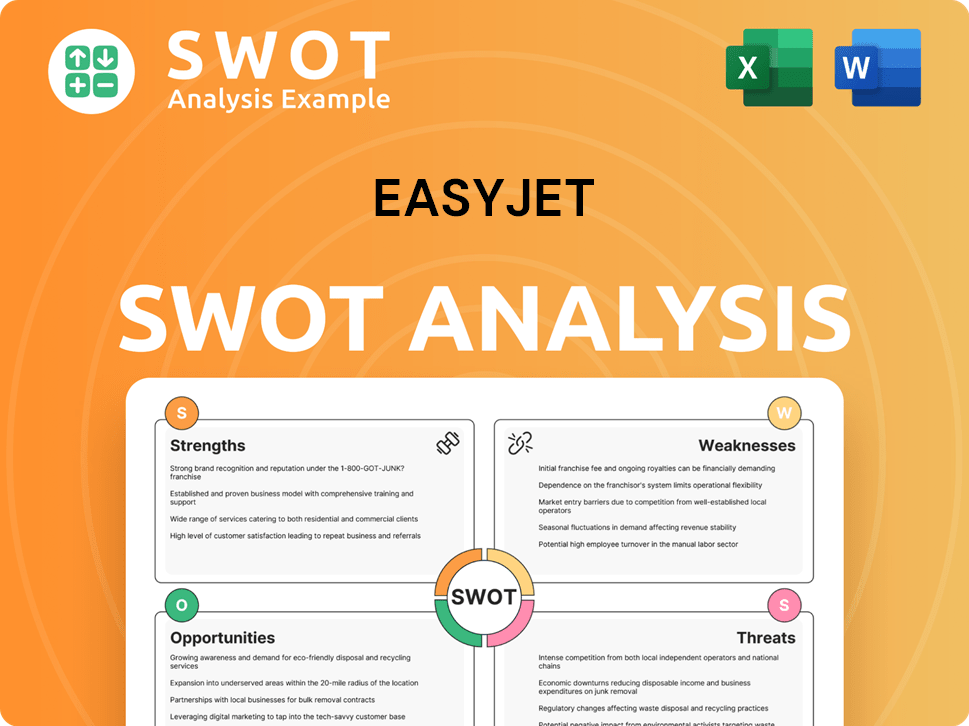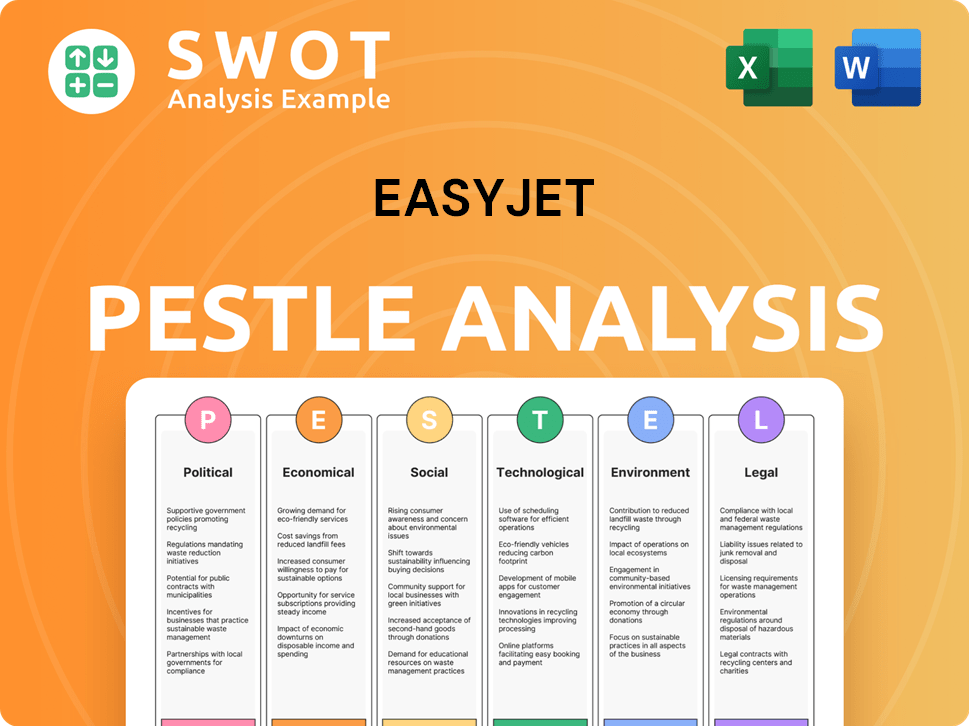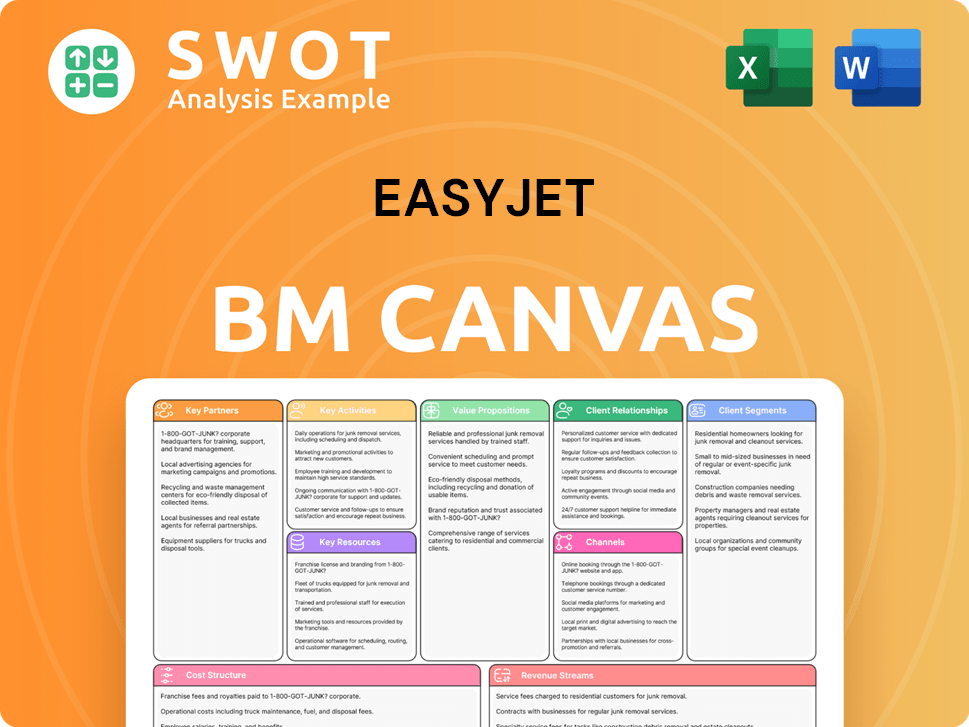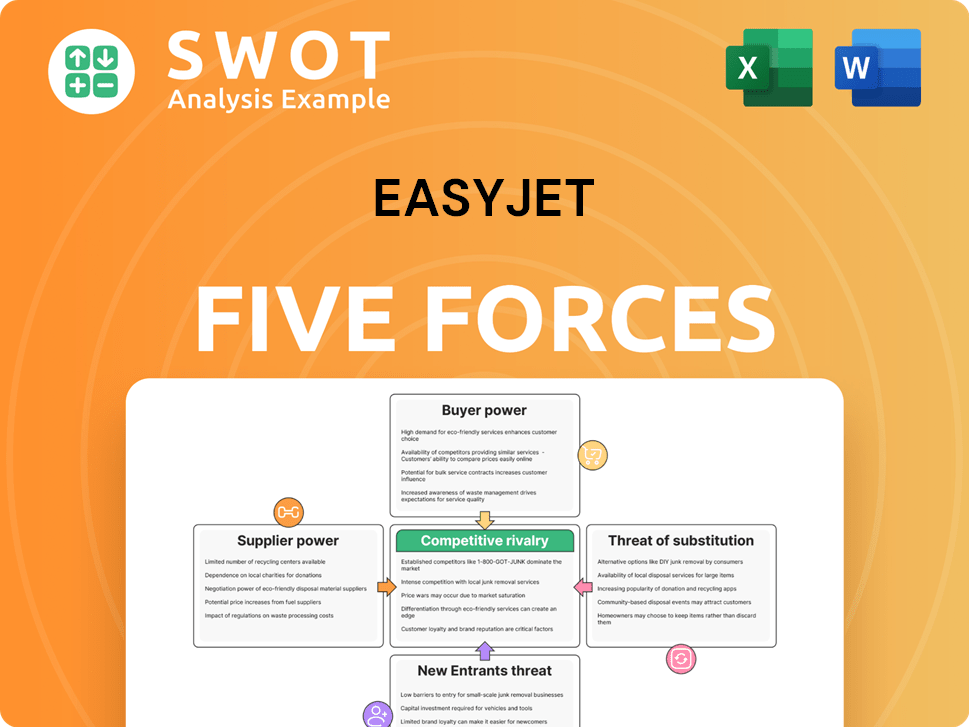easyJet Bundle
How Does easyJet Dominate the European Skies?
The European airline industry is a battleground, with low-cost carriers constantly vying for supremacy. easyJet, a pioneer in this arena, has built a formidable presence by offering budget-friendly travel options. But how does this airline truly stack up against its rivals?

From its inception in 1995, easyJet has revolutionized air travel, expanding its fleet and network to become a leading European airline. A thorough easyJet SWOT Analysis reveals the core strategies that have fueled its growth. This analysis will dissect the easyJet competitive landscape, examining its easyJet competitors and providing a detailed easyJet market analysis to understand its position in the airline industry within the European aviation sector.
Where Does easyJet’ Stand in the Current Market?
easyJet currently holds a strong position in the European short-haul aviation market, operating primarily as a leading low-cost carrier. The airline is a major player in the Growth Strategy of easyJet, consistently ranking among the top airlines in Europe by passenger numbers and fleet size. easyJet focuses on point-to-point connections between major European cities and popular holiday destinations, serving both leisure and business travelers.
The airline's core flight services are complemented by ancillary revenues from baggage fees, seat selection, and other add-ons, crucial to its low-cost business model. easyJet's primary product lines revolve around its core flight services, complemented by ancillary revenues generated from baggage fees, seat selection, and other add-ons, which are crucial to its low-cost business model. Its strategic focus on optimizing its network and increasing ancillary revenue streams has contributed to its resilience and continued strong performance within its core European short-haul markets.
Geographically, easyJet has a significant presence across Western Europe, with key bases in countries such as the UK, France, Germany, Italy, and Switzerland. The UK remains a particularly strong market for easyJet, where it holds a significant share of the short-haul international market. In the fiscal year ending September 30, 2023, easyJet reported a significant increase in passenger numbers, reaching 82.8 million, indicating its strong recovery and continued relevance in the post-pandemic travel landscape.
easyJet consistently ranks among the top airlines in Europe by passenger numbers. For the fiscal year ending September 30, 2023, easyJet reported 82.8 million passengers. This demonstrates its strong recovery and continued relevance in the post-pandemic travel landscape.
easyJet's financial health is evidenced by its reported revenue of £8.17 billion for the fiscal year 2023. It also reported a pre-tax profit of £455 million, positioning it as a financially stable entity compared to many industry averages.
easyJet has a substantial presence across Western Europe, with key bases in the UK, France, Germany, Italy, and Switzerland. The UK remains a particularly strong market for easyJet, where it holds a significant share of the short-haul international market.
easyJet primarily serves the leisure and business travel segments, focusing on point-to-point connections between major European cities and popular holiday destinations. Its primary product lines revolve around its core flight services, complemented by ancillary revenues.
easyJet's competitive landscape is shaped by its low-cost model and focus on short-haul routes. The airline faces competition from other low-cost airlines and legacy carriers within the European aviation market. The airline's financial performance and strategic adjustments are key factors in maintaining its market position.
- easyJet's main rivals in Europe include Ryanair, Wizz Air, and other budget airlines.
- The airline's pricing strategy is crucial in attracting price-sensitive customers.
- easyJet's route network analysis highlights its focus on popular destinations.
- The impact of COVID-19 on easyJet's competition has led to strategic adjustments.
easyJet SWOT Analysis
- Complete SWOT Breakdown
- Fully Customizable
- Editable in Excel & Word
- Professional Formatting
- Investor-Ready Format

Who Are the Main Competitors Challenging easyJet?
The easyJet competitive landscape is characterized by intense rivalry within the European aviation market. Several key players vie for market share, employing various strategies to attract passengers. Understanding these competitors is crucial for evaluating easyJet's position and future prospects.
easyJet's market analysis reveals a dynamic environment where pricing, route networks, and operational efficiency are critical factors. The airline faces competition from both established low-cost carriers and traditional airlines, each with unique strengths and weaknesses. This competitive pressure influences easyJet's strategic decisions, including route expansion, pricing strategies, and customer service enhancements.
The airline industry is constantly evolving, with mergers, acquisitions, and new entrants reshaping the competitive landscape. easyJet must adapt to these changes to maintain its market position and profitability. This chapter provides an overview of easyJet's main rivals, their strategies, and the overall competitive dynamics within the European aviation market.
Ryanair is often considered easyJet's primary competitor. It is the largest airline in Europe by passenger numbers. Ryanair's aggressive pricing and extensive route network give it a strong competitive advantage.
Wizz Air is a rapidly expanding low-cost carrier, particularly in Central and Eastern Europe. It competes fiercely on price and network growth in the regions it serves. Wizz Air's focus on cost efficiency allows it to offer competitive fares.
British Airways, part of the IAG Group, competes with easyJet on many routes, especially on those from London. British Airways has introduced basic economy fares to compete with low-cost carriers. IAG's subsidiaries, like Vueling and LEVEL, also compete in the low-cost market.
Air France-KLM, a traditional airline, competes with easyJet on various routes, particularly within its European network. Like British Airways, it has introduced budget-friendly options. The group's low-cost strategies impact easyJet's market share.
The Lufthansa Group, another major player, competes with easyJet through its main brand and its low-cost subsidiary, Eurowings. Eurowings focuses on budget travel, increasing competition on short-haul routes. This strategy impacts easyJet's pricing and route planning.
Emerging players and smaller regional airlines also contribute to the competitive pressure, especially on specific routes or in niche markets. The ongoing consolidation within the industry, including potential mergers and alliances, could further reshape the competitive dynamics.
easyJet's competitive advantages include its strong brand recognition and established presence in key European markets. However, it faces challenges from rivals with lower operating costs and more extensive route networks. Competitive pricing on popular routes is a common strategy, as is network expansion into rival strongholds. The airline industry's constant evolution, including mergers and alliances, further shapes the competitive landscape.
- Pricing Strategies: Competitors often engage in price wars, especially on popular routes. Ryanair is known for its aggressive pricing.
- Route Network: Expansion into new routes and the development of hub-and-spoke systems are crucial. Ryanair has a very extensive network.
- Operational Efficiency: Low operating costs are essential for profitability. Wizz Air is known for its cost-effectiveness.
- Customer Service: Differentiation through customer service can attract and retain passengers. easyJet has been working to improve its customer service.
- Fleet Management: Efficient fleet management, including aircraft utilization and maintenance, impacts costs. easyJet's fleet size is a factor in its competitive position.
easyJet PESTLE Analysis
- Covers All 6 PESTLE Categories
- No Research Needed – Save Hours of Work
- Built by Experts, Trusted by Consultants
- Instant Download, Ready to Use
- 100% Editable, Fully Customizable

What Gives easyJet a Competitive Edge Over Its Rivals?
The Growth Strategy of easyJet is built upon several key competitive advantages that have allowed it to thrive in the challenging airline industry. These advantages include a strong brand reputation, an extensive route network, operational efficiency, and robust digital capabilities. These factors contribute to easyJet's ability to maintain a competitive edge in the European aviation market.
easyJet's brand is widely recognized across Europe, synonymous with affordable and reliable air travel. This brand recognition fosters significant customer loyalty, allowing the airline to attract a large customer base and exert some pricing power within the low-cost segment. Its established network of routes, connecting major European cities and leisure destinations, provides convenience and choice, making it difficult for new entrants to replicate quickly. These elements contribute to easyJet's strong position in the competitive landscape.
Operational efficiency is a cornerstone of easyJet's business model, enabling it to keep costs low. The airline benefits from economies of scale through its large fleet of Airbus A320 family aircraft, optimizing maintenance and crew training. High aircraft utilization and quick turnaround times at airports maximize the number of flights per day, boosting revenue per aircraft. These operational efficiencies are crucial in the highly price-sensitive low-cost airline market, allowing easyJet to maintain a competitive advantage.
easyJet's brand is well-established and trusted across Europe, fostering customer loyalty. This allows the airline to attract a large customer base and maintain a degree of pricing power. The strong brand recognition is a key factor in its competitive advantage within the low-cost airlines sector.
easyJet boasts an extensive network of routes, connecting major European cities and leisure destinations. This provides travelers with convenience and choice, making it difficult for competitors to replicate. The well-developed network is a significant advantage in the airline industry.
Operational efficiency is a core strength, with easyJet benefiting from economies of scale and high aircraft utilization. Quick turnaround times and a focus on cost management allow the airline to offer competitive pricing. This efficiency is critical in the low-cost airline market.
easyJet has invested heavily in its digital platforms, offering a seamless online booking experience. The mobile app is highly rated, enhancing customer convenience and driving repeat bookings. These digital capabilities support customer engagement and revenue generation.
easyJet's competitive advantages are multifaceted, including a strong brand, extensive route network, operational efficiency, and digital prowess. These elements work together to create a robust business model, allowing easyJet to compete effectively in the European aviation market. These advantages contribute to its sustained success.
- Brand Strength: A well-recognized brand with high customer loyalty.
- Route Network: A comprehensive network connecting major cities.
- Operational Efficiency: Low costs through economies of scale and high aircraft utilization.
- Digital Innovation: A seamless online experience and mobile app.
easyJet Business Model Canvas
- Complete 9-Block Business Model Canvas
- Effortlessly Communicate Your Business Strategy
- Investor-Ready BMC Format
- 100% Editable and Customizable
- Clear and Structured Layout

What Industry Trends Are Reshaping easyJet’s Competitive Landscape?
The easyJet competitive landscape within the European aviation industry is dynamic, shaped by evolving industry trends, emerging challenges, and potential opportunities. The airline faces intense competition from other low-cost airlines and established carriers. Understanding these factors is crucial for assessing easyJet's market analysis and future prospects.
The airline industry in Europe is experiencing significant shifts, including technological advancements, regulatory changes, and evolving consumer preferences. These elements influence easyJet's competitors and its strategic decisions. The company must adapt to these changes to maintain its position and capitalize on growth opportunities.
Technological advancements, especially in sustainable aviation fuels (SAFs) and electric aircraft, are becoming increasingly important. Regulatory changes related to environmental targets and passenger rights are also creating new compliance burdens. Consumer preferences are shifting towards more sustainable travel options, and there is a growing demand for seamless digital experiences.
Intense competition from ultra-low-cost carriers, such as Ryanair and Wizz Air, could erode easyJet's market share. Increased regulation regarding carbon emissions could lead to higher operating costs. Declining demand in certain markets due to economic downturns or geopolitical events also presents a risk.
The increasing demand for leisure travel, particularly for short breaks and city trips, aligns well with its core offering. Investing in new technologies, such as advanced data analytics for network optimization and personalized customer experiences, could further enhance its competitive edge. Strategic partnerships with other travel providers could also unlock new revenue streams and expand its reach.
Fleet modernization to improve fuel efficiency is a key focus. Exploring SAF options and enhancing digital platforms to improve customer engagement and operational efficiency are also priorities. The company continues to focus on ancillary services for revenue growth.
easyJet's success hinges on adapting to industry changes and mitigating risks. The company's ability to manage costs, particularly fuel expenses, is essential. The evolving landscape of the European aviation sector requires continuous strategic adjustments.
- Competitive Pressures: The airline faces significant pressure from rivals like Ryanair, which has a larger fleet and often lower fares.
- Sustainability: Increasing focus on reducing carbon emissions requires investments in SAFs and more fuel-efficient aircraft.
- Economic Factors: Economic downturns and inflationary pressures can impact demand for air travel, affecting profitability.
- Technological Innovation: Leveraging data analytics and digital platforms is crucial for enhancing customer experience and operational efficiency.
For a deeper understanding of the company's origins and evolution, you can read a Brief History of easyJet. As of late 2023, easyJet reported a strong recovery in passenger numbers, with a load factor of approximately 87%. However, the airline continues to face challenges, including rising fuel costs and increased competition, particularly from Ryanair, which has a larger market share. easyJet's strategic focus on cost management and ancillary revenues will be critical for its future success. The company is also investing in fleet renewal to improve fuel efficiency, with plans to add new aircraft to its fleet by 2025. The airline's ability to navigate these challenges and capitalize on opportunities will determine its long-term competitive position. In 2024, the airline aims to increase its capacity and expand its route network, with a focus on leisure destinations.
easyJet Porter's Five Forces Analysis
- Covers All 5 Competitive Forces in Detail
- Structured for Consultants, Students, and Founders
- 100% Editable in Microsoft Word & Excel
- Instant Digital Download – Use Immediately
- Compatible with Mac & PC – Fully Unlocked

Related Blogs
- What are Mission Vision & Core Values of easyJet Company?
- What is Growth Strategy and Future Prospects of easyJet Company?
- How Does easyJet Company Work?
- What is Sales and Marketing Strategy of easyJet Company?
- What is Brief History of easyJet Company?
- Who Owns easyJet Company?
- What is Customer Demographics and Target Market of easyJet Company?
Disclaimer
All information, articles, and product details provided on this website are for general informational and educational purposes only. We do not claim any ownership over, nor do we intend to infringe upon, any trademarks, copyrights, logos, brand names, or other intellectual property mentioned or depicted on this site. Such intellectual property remains the property of its respective owners, and any references here are made solely for identification or informational purposes, without implying any affiliation, endorsement, or partnership.
We make no representations or warranties, express or implied, regarding the accuracy, completeness, or suitability of any content or products presented. Nothing on this website should be construed as legal, tax, investment, financial, medical, or other professional advice. In addition, no part of this site—including articles or product references—constitutes a solicitation, recommendation, endorsement, advertisement, or offer to buy or sell any securities, franchises, or other financial instruments, particularly in jurisdictions where such activity would be unlawful.
All content is of a general nature and may not address the specific circumstances of any individual or entity. It is not a substitute for professional advice or services. Any actions you take based on the information provided here are strictly at your own risk. You accept full responsibility for any decisions or outcomes arising from your use of this website and agree to release us from any liability in connection with your use of, or reliance upon, the content or products found herein.